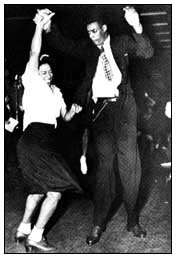
JAZZ DANCE: Marshall Stearn's book "Jazz Dance" has been a major reference work in early jazz, tap, and Lindy Hop since its publication. However, a considerable amount of information in one of the chapters supplied by veteran Lindy Hoppers Leon James and Al Minns has been vigorously denied by Lindy Luminary Frank Manning. In a 3/2/99 phone conversation between Frank and myself, it seems that Leon and Al offered writer Stearns a lot of total fabrications for their own amusement. Frank suggested that, since their association occurred well before the Lindy Hop revival of the '90s, the pair had no idea of the eventual historical significance of Stearns' document.
A panel that included Frank was created approach the publisher in terms of correcting errors in a subsequent edition, but nothing came of it. So here it is in public for the first time:
1. Cat's Corner An unauthorized dancer in the elite area of the Savoy might be permanently disabled by another dancer, his shins broken with devastingly executed Charleston kicks. Or he might be simply hauled off by roughneck watchdogs, and mercilessly beaten to a pulp. (No, says Frank. Newcomers with enough ego to try were welcome to the Cat's Corner. Showing their stuff, they would either be admired, or humbled.)
2. Copying moves of the Cat's Corner elite was not regarded as too cool, either. Unpleasant physical retribution by the heavies could result. (No, that's ridiculous, says Frank. Just like today, everyone copied everyone else's moves, even their signature moves. No sweat. That's how the dance grew and propagated .)
3. The Jolly Fellows: In 1923, Whitey organized the secret gang, "The Jolly Fellows." Through the Savoy years, membership grew to over 600 strong. The Jolly Fellows were not just a club; they were a gang, feared by the law. (No, says Frank, it was a dancers club, NOT a gang. No fights, no punching a store owner on the jaw as an initiation.)
4. Cops: An officer of the law was dumped in the garbage by a gang member, and the precinct ignored the whole thing. They were afraid of the gangs. (Nope, says Frank. Even though corrupt, the cops had the power: you didn't mess with them. This "incident" was yet another tall tale.)
5. The Renaissance Ballroom
gang murder: Whitey and some club members exacted mortal knife-point
revenge on a Buffaloes club member. And this, brazenly before a crowd of stunned
dancers in the Renaissance Ballroom , after "kicking him to pieces" As usual,
the police washed their hands of the whole matter. ( Frank and some club
members ran over to the Renaissance when they heard there was a fight, but there
was no guy falling off the balconey from a punch, no knifing, and no murder.
Also, the guy did not get beat up as bad as James said in the book.)
Photo: Stompin' The Blues, op. cit.
Since this article hit the web, some historians have responded with reservations on Frank's rebuttal: Harlem was truly a pretty rough place. However, the respect that most of us have for Frank Manning is profound: his observations on the topic are more than significant. In the phone interview, Frank was both quite emotional, annoyed at the misrepresentaion of history, and at the publishers for refusing to edit the next edition, and absolutely serious about his side of the story.
Feel like dancing?
Let's go to the SAVOY!